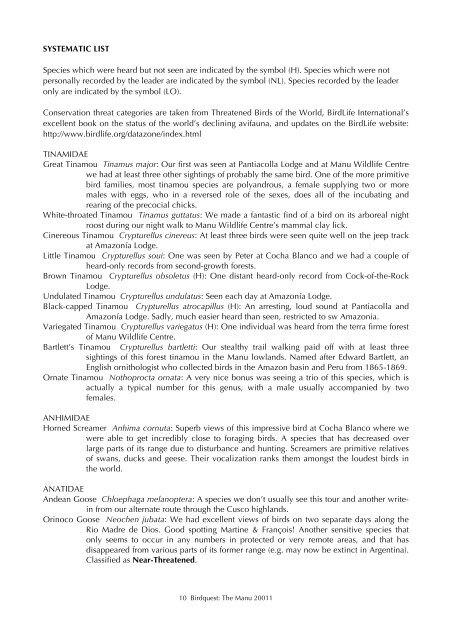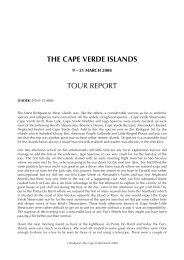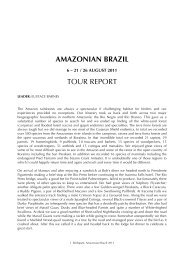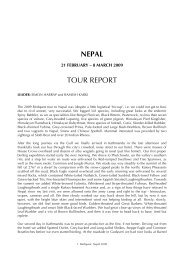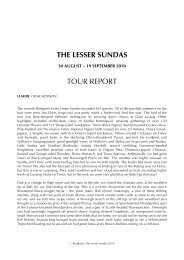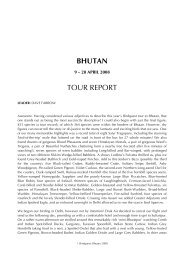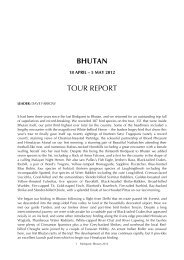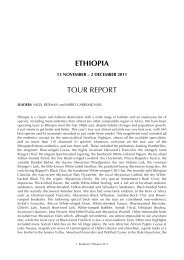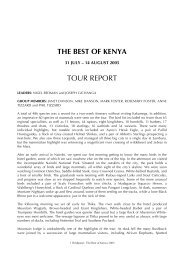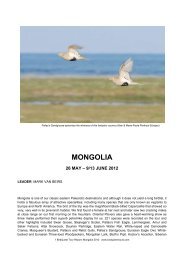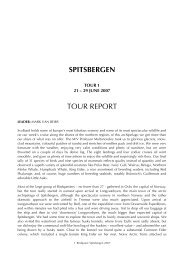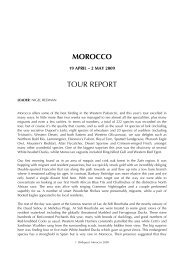Download Full Tour Report 1202kb - Birdquest
Download Full Tour Report 1202kb - Birdquest
Download Full Tour Report 1202kb - Birdquest
Create successful ePaper yourself
Turn your PDF publications into a flip-book with our unique Google optimized e-Paper software.
SYSTEMATIC LIST<br />
Species which were heard but not seen are indicated by the symbol (H). Species which were not<br />
personally recorded by the leader are indicated by the symbol (NL). Species recorded by the leader<br />
only are indicated by the symbol (LO).<br />
Conservation threat categories are taken from Threatened Birds of the World, BirdLife International’s<br />
excellent book on the status of the world’s declining avifauna, and updates on the BirdLife website:<br />
http://www.birdlife.org/datazone/index.html<br />
TINAMIDAE<br />
Great Tinamou Tinamus major: Our first was seen at Pantiacolla Lodge and at Manu Wildlife Centre<br />
we had at least three other sightings of probably the same bird. One of the more primitive<br />
bird families, most tinamou species are polyandrous, a female supplying two or more<br />
males with eggs, who in a reversed role of the sexes, does all of the incubating and<br />
rearing of the precocial chicks.<br />
White-throated Tinamou Tinamus guttatus: We made a fantastic find of a bird on its arboreal night<br />
roost during our night walk to Manu Wildlife Centre’s mammal clay lick.<br />
Cinereous Tinamou Crypturellus cinereus: At least three birds were seen quite well on the jeep track<br />
at Amazonía Lodge.<br />
Little Tinamou Crypturellus soui: One was seen by Peter at Cocha Blanco and we had a couple of<br />
heard-only records from second-growth forests.<br />
Brown Tinamou Crypturellus obsoletus (H): One distant heard-only record from Cock-of-the-Rock<br />
Lodge.<br />
Undulated Tinamou Crypturellus undulatus: Seen each day at Amazonía Lodge.<br />
Black-capped Tinamou Crypturellus atrocapillus (H): An arresting, loud sound at Pantiacolla and<br />
Amazonía Lodge. Sadly, much easier heard than seen, restricted to sw Amazonia.<br />
Variegated Tinamou Crypturellus variegatus (H): One individual was heard from the terra firme forest<br />
of Manu Wildlife Centre.<br />
Bartlett’s Tinamou Crypturellus bartletti: Our stealthy trail walking paid off with at least three<br />
sightings of this forest tinamou in the Manu lowlands. Named after Edward Bartlett, an<br />
English ornithologist who collected birds in the Amazon basin and Peru from 1865-1869.<br />
Ornate Tinamou Nothoprocta ornata: A very nice bonus was seeing a trio of this species, which is<br />
actually a typical number for this genus, with a male usually accompanied by two<br />
females.<br />
ANHIMIDAE<br />
Horned Screamer Anhima cornuta: Superb views of this impressive bird at Cocha Blanco where we<br />
were able to get incredibly close to foraging birds. A species that has decreased over<br />
large parts of its range due to disturbance and hunting. Screamers are primitive relatives<br />
of swans, ducks and geese. Their vocalization ranks them amongst the loudest birds in<br />
the world.<br />
ANATIDAE<br />
Andean Goose Chloephaga melanoptera: A species we don’t usually see this tour and another writein<br />
from our alternate route through the Cusco highlands.<br />
Orinoco Goose Neochen jubata: We had excellent views of birds on two separate days along the<br />
Rio Madre de Dios. Good spotting Martine & François! Another sensitive species that<br />
only seems to occur in any numbers in protected or very remote areas, and that has<br />
disappeared from various parts of its former range (e.g. may now be extinct in Argentina).<br />
Classified as Near-Threatened.<br />
10 <strong>Birdquest</strong>: The Manu 20011


